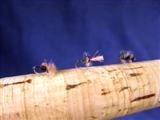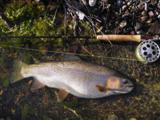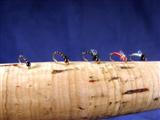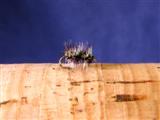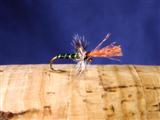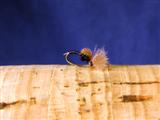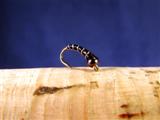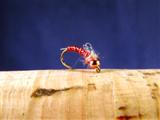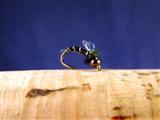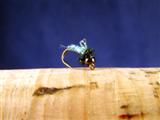River Midge Fishing Tactics - Part 2
This blog is the second of two articles written on fishing river midge hatches during the winter and spring. The first article, focusing on the midge lifecycle and where to find midge-feeding fish, can be found here.
Midge Pattern Setup, Presentations, and Techniques
I almost always use two flies when fishing midge patterns. The patterns are usually small and the trout are less willing to move to feed, so fishing multiple flies allows you to fish two current lanes, two water depths, or two insect stages at once. These methods will need to be adapted if fishing regulations prevent you from fishing multiple flies simultaneously.
Fishing an Adult and an Emerger
Pools and Back Eddies
When fishing a pool or back eddy where trout are sitting near the surface, fishing a tandem rig of an adult pattern and an emerging pattern can be deadly. The emerging pattern is sometimes invisible on the water’s surface due to broken water or high surface glare, so the adult pattern works double duty as both an adult midge and a strike indicator. Fish the combination dead drift in the current, or let it sit motionless along the edge of a pool when trout are cruising and feeding. If you see a rise near your adult, wait briefly to see if your adult disappears. If it does, set the hook!
I often fish the Griffith’s Gnat as my adult pattern. It is a good floating fly, even in small sizes, and represents a cluster of midges on the water’s surface. For a midge emerger, I recommend Scott Sanchez’s Parachute Midge Emerger or a CDC Loop Tuft Emerger. Both patterns hang vertically in the water, yet are quite visible to the angler because of the tuft that sits above the water’s surface. The CDC Loop Tuft Emerger is especially good in slightly broken water or swirling back eddies. The CDC is very buoyant and can bring the pattern back to the surface if it is swamped by a wavelet or pulled under by the tippet. I highly recommend using a product like Frog’s Fanny desiccant to dry out the CDC tuft after catching a fish, or after the fly has started to sink.
To assemble the rig, first attach the dry fly to your 5x or smaller tippet. Then, attach an 18” to 24” strand of 5x or smaller tippet to the bend of the dry fly hook using an improved clinch knot. Attach the emerger pattern to the end of this tippet.
Fishing an Adult and a Shallow Nymph
Pools, Back Eddies, and Shallow Riffles
Fishing an adult pattern with a midge nymph pattern as a dropper is the most effective way I’ve found to fish to active trout feeding on midges. It is also one of the most exciting. The adult pattern catches the occasional fish, but more often than not the midge nymph will be the top producer. When fishing this rig, cast the flies ahead of rising trout or fish feeding in a back eddy or shallow riffle. Watch the dry fly intently – it will often disappear when the flies drift over a feeding trout. When it happens, set the hook!
With this tactic, trout are often partially or wholly visible to the angler during the entire presentation. In slower water, trout have time to take in your nymph pattern, taste it, and spit it back out without your dry fly ever moving. As your skills progress with this technique, begin setting the hook when you see your targeted trout’s mouth open, or you see the fish move to the side a few inches. These activities are signs that the fish has just taken your nymph. Quickly and fluidly set the hook; if the fish isn’t on, false cast to the side and re-present your patterns to the fish. Catching a trout based solely on seeing it react to your fly, but never seeing an indication from your strike indicator or dry fly, is as good as it gets for me in fly fishing.
Even when a pod of trout are feeding actively on the surface, they are usually very receptive to a sunken midge pupa pattern. I attach a tag of 5x or 6x tippet to the bend of the dry fly hook, then attach the midge nymph to end of the tag. The water depth, fish depth and water current speed dictate the length of the tippet tag. If trout are holding just under the surface in a pool, I will place the dropper 6” to 12” from the adult. If trout are 1’ to 2’ deep in the pool, or are sitting in a shallow back eddy, I will use a dropper length of 12” to 24”. Occasionally, if the fish are suspended in a slow, deep riffle, I will use a dropper of up to 36”. Anything deeper than that and I will switch tactics since it’s unlikely that the adult midge pattern will be of any use.
My favorite midge larva/pupa pattern is the zebra midge. It is as simple a pattern as any, consisting of a bead head, thread body, and fine wire ribbing. On my local rivers, the predominant color of midge is black or dark olive, so I fish a black zebra midge at least 75% of the time. It is very successful.
An alternative way to fish a shallow midge larva or pupa pattern is to not use a dry fly at all, instead fishing one sunken fly and using a pinch-on float or strike putty on the leader to control the fly depth and determine strikes. It is easier to add a tiny splitshot to the tippet with this method to help sink the nymph, since the float will not sink with the added weight.
Fishing Two Shallow Midge Nymphs
Pools, Back Eddies, and Riffles
When fish aren’t feeding at the surface or just underneath it, fishing a tandem midge nymph rig is an effective way to cover deeper water and catch active fish. This is an effective technique for covering riffles where fish can’t be spotted, fishing to spotted fish that are sitting deep in a back eddy or pool, or blindly nymphing likely fish-holding water. One of the benefits of this method of fishing is being able to vary pattern size and color to find a trout’s preference.
When rigging for this setup, I attach the first fly to the tippet, then attach a tag end of tippet to the eye of the first fly. I attach a second midge nymph 18” to 24” from the first fly. A pinch-on float attached to the leader above the first fly acts as both a strike indicator and a water depth regulator. I vary the location of the float based on the water depth, fish depth, and water current speed. When trout are actively feeding on midge pupa, I find that trout don’t necessarily hold to the bottom of the river, so fishing the flies at or near the bottom isn’t the best bet. I try to suspend the flies in the water column. If the current is fast enough, I’ll add small splitshot to the leader 6” to 8” above the first fly. If I’m snagging the bottom or the indicator keeps twitching because the nymphs are bouncing along the bottom, I’ll move the float closer to the first fly to keep the nymphs suspended.
I use zebra midges and disco zebra midgelings for most of my tandem midge nymphing. The disco zebra midgeling is more of an attractor midge pattern compared to the more-realistic zebra midge, and it can be deadly. I have fished zebra midges to spotted, actively-feeding fish before that have snubbed multiple quality drifts. After changing flies to a disco zebra midgeling, the trout have moved a foot-plus out of their feeding lanes to aggressively take the pattern! It doesn’t work all the time, but it’s a pattern I wouldn’t go fishing without. Black and red are my standard colors for the pattern, but surprisingly a light blue disco zebra midgeling has proven very effective on multiple occasions.
Deep Nymphing
Deep Back Eddies, Faster Riffles
Deep nymphing with a midge nymph can be a useful fishing tactic. It is not one of my favorite tactics to employ when midge fishing simply because fish cannot be spotted and fished to individually. However, it can be more effective than the other tactics early or late in the day or when midges aren’t hatching or active. For rivers with good stonefly populations, the large stonefly nymphs will be a trout staple during the winter and spring months when mayfly and caddis nymphs are either still eggs or microscopic in size. Try fishing a small zebra midge or disco zebra midgeling as a dropper 12” to 18” off a large stonefly nymph.
Midge Fishing Tips and Tricks
Adult midge patterns don’t always float all that well. Nymph patterns used as a dropper off the adult can sink the adult, and swirling microcurrents in pools and back eddies can swamp the adult by pulling the leader under. I often attach a pinch-on float a couple feet up the leader from the adult. The float acts as an indicator for spotting your tiny dry fly as it floats in foam or riffles, and also keeps the leader from sinking and pulling the adult under.
When trout are rising under foam mats, two problems present significant obstacles to catching fish: presenting a fly that the fish can see, and presenting a fly that the angler can see. I often fish midge emerger patterns in these situations, like the parachute midge emerger or CDC loop-tuft emerger. Because these patterns ride vertically in the water, they will hang down below the surface of the water and foam, making an easy target to fish. One key is to cast your fly into breaks in the foam – if the fly lands on top of the foam, it will likely not be visible at all to the trout. Do not cast until you can present your fly on a patch of open water. The second obstacle is that once you’ve cast, it’s nearly impossible to see your fly amid all of the foam and floating debris. I solve this by adding a small ball of strike putty a short distance up from the emerger pattern. The strike putty sticks out nicely against the mess, and provides a strike indicator if the fish takes the emerger without me seeing it.
Midge Patterns
I use the following patterns with regular success on my local tailwaters and freestone streams that feature good midge hatches in the winter and spring months. Modify the pattern colors to match local hatches. The light blue Disco Zebra Midgeling is a surprisingly effective attractor pattern at times. Tying instructions for the Disco Zebra Midgeling can be found here.
Comments
Douglas Randall
Most helpfull. Last week I was fishing E Pa stream low water I think the fish were taking midges. They would look hard at beetles but no takes.


